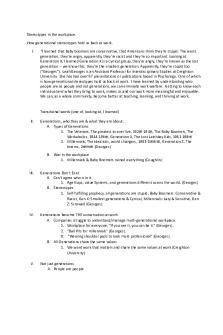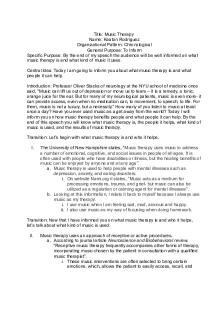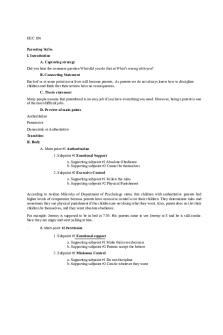COM 100 Benefits of Yoga Informative Speech PDF

| Title | COM 100 Benefits of Yoga Informative Speech |
|---|---|
| Author | Halley Myers |
| Course | Communication Fundamentals |
| Institution | University of Rhode Island |
| Pages | 9 |
| File Size | 91.9 KB |
| File Type | |
| Total Downloads | 53 |
| Total Views | 142 |
Summary
Taken with Emma Gabriele....
Description
Benefits of Yoga Informative Speech Outline Hello everybody! For those of you that do not know me, my name is Halley. Over the summer, I attended my first hot yoga session in Providence. After signing in and taking off my shoes, I entered the 105 F room and laid my yoga mat out, patiently waiting for the instructor to start the session. Because it was my first time, and Bikram, or hot yoga is one of the more advanced classes offered, I felt overwhelmed as soon as she began spitting out terms such as “Child’s pose,” “warrior,” and “downward dog.” The hour and fifteen minute class was difficult; however, after leaving the room, I felt a great sense of pride, accomplishment, and most importantly, a deep mind-body connection. And now that I have shared my yoga experience, I want to introduce you all to this healthy practice. However, most of you may be wondering, “How can yoga help me?” Hopefully I can help you answer that question by informing you about the physical, mental, and internal benefits of yoga. But in order to understand its benefits, I want to first go over what yoga truly is. According to Robin J. Wilson, a writer in the American Journal of Nursing, yoga is “an ancient art and science that aims for high-level wellness… the word yoga means ‘yoke’ or ‘union’ and reflects its holistic approach.” In yoga, union occurs in the mind, body, and spirit. Furthermore, “yoga exercise, or asana, consists of slowly stretching and bending oneself into a particular position without strain or pain, holding that position for a length of time…and then releasing the pose as slowly as it was assumed.” After doing so, a rest period follows, “maximizing the relaxing effects of the pose” and preventing fatigue.
Although it is such an old practice, it has become increasingly popular in more recent times. According to HealthDay Reporter Alan Mozes, two new government surveys show that in 2002, less than 6% of adults in the U.S. said that they have tried yoga. However, in 2012, more than 10% said that they’ve tried it. The second survey in 2012 represented an increase of about 400,000 children practicing yoga since 2007. This increase is the result of individuals seeing yoga as a necessary approach to health, considering it as complementary medicine. It is regarded as a necessary approach to health because of its benefits. According to the American Osteopathic Association, “yoga delivers many benefits to those who incorporate it into their everyday lives [creating] strength, awareness, and harmony in both the mind and body.” While there are many different types of yoga, most sessions are comprised of breathing exercises, meditation, and assuming postures, leading to physical, mental, and internal benefits. These physical and internal benefits include increased flexibility; increased muscle strength and tone; improved respiration, energy, and vitality; the maintenance of a balanced metabolism; weight reduction; cardio and circulatory health; improved athletic performance; and protection from injury. The AOA also states that there are many mental benefits of yoga. It helps a person manage stress, which can have devastating effects on the body and mind if not prevented or managed. According to Dr. Nevins, “Yoga can be very effective in developing coping skills and reaching a more positive outlook on life.” Yoga’s incorporation of meditation and breathing can additionally improve a person’s overall mental well-being. Regular practice creates mental clarity and
calmness, increased body awareness, relieves chronic stress patterns, relaxes the mind, centers attention, and sharpens concentration. Although all kinds of yoga will provide you with these benefits, focusing on a specific kind of yoga will target specific mental or physical areas, leading to more localized benefits. According to Dr. Richard Weil, Hatha is a gentle practice where you move slowly and smoothly through dozens of asanas. The focus is on holding the poses and integrating your breathing into the movement. Its benefits include flexibility, improved muscle strength, stress reduction, increased body alignment, and better balance. Kundalini yoga emphasizes rapid movement through the poses and emphasizes breathing, chanting, and meditation, focusing on energy balance within the body. Its benefits are the same of that as Hatha; however, Kundalini yoga allows for a deeper mind-body connection and increased energy and vitality. Bikram yoga is practiced in a room heated to about 105 F. Its benefits include loosening of the muscles, cleanse of the body, and removal of the symptoms of a disease and chronic pain. However, it is important to drink a lot of water before going to a Bikram session because the intense heat may cause dehydration. The last type I will talk about is ashtanga, or power, yoga. In ashtanga, there is little emphasis on meditation, as the focus is moving from one pose to another very quickly, making it more of a workout. Its benefits include improved strength and endurance. As a whole, yoga is a healthy practice that provides physical, mental, and internal benefits. In addition, focusing on specific kinds of yoga can provide specific kinds of benefits.
With that, I hope you have learned about what yoga truly is and how it can be beneficial to your overall health. Thank you for listening.
I.
Introduction: 1. Open up with a personal experience. a. Share the experience of doing hot yoga over the summer. 2. Introduce topic. a. Yoga a very healthy practice that has a wide array of benefits. 3. Transition with a question and preview main points. a. Grab audience’s attention and state the thesis, previewing main points. i. Most of you may be wondering: How can yoga help me? Hopefully I can help you answer that question by informing you about the wide array of benefits occurring in both the mind and body. b. Transition to the definition of yoga. i. But in order to understand its benefits, I want to first go over what yoga truly is.
II.
Body 1. What exactly is yoga? a. According to AJN writer Robin J. Wilson, “yoga is an ancient art and science that aims for high-level wellness. The word yoga means ‘yoke’ or ‘union’ and reflects its holistic approach.” In yoga, union occurs in the mind, body, and spirit. Furthermore, “yoga exercise, or asana, consists of slowly stretching and bending oneself into a particular position without strain or pain, holding that position for a length of time and then releasing the pose as slowly as it was assumed.” After doing so, a rest period
follows, “maximizing the relaxing effects of the pose” and preventing fatigue. b. Although it is such an old practice, it has become increasingly popular in more recent times. According to HealthDay Reporter Alan Mozes, two new government surveys show that in 2002, less than 6% of adults in the U.S. said that they have tried yoga. However, in 2012, more than 10% said that they’ve tried it. The second survey in 2012 represented an increase of about 400,000 children practicing yoga since 2007. This increase is the result of individuals seeing yoga as a necessary approach to health, considering it as complementary medicine. c. It is regarded as a necessary approach to health because of its benefits. 2. The benefits of yoga a. According to the American Osteopathic Association, “yoga delivers many benefits to those who incorporate it into their everyday lives [creating] strength, awareness, and harmony in both the mind and body.” b. While there are many different types of yoga, most sessions are comprised of breathing exercises, meditation, and assuming postures, leading to physical, mental, and internal benefits. c. These physical and internal benefits include increased flexibility; increased muscle strength and tone; improved respiration, energy, and vitality; the maintenance of a balanced metabolism; weight reduction; cardio and circulatory health; improved athletic performance; and protection from injury.
d. The AOA also states that there are many mental benefits of yoga. It helps a person manage stress, which can have devastating effects on the body and mind if not prevented or managed. According to Dr. Nevins, “Yoga can be very effective in developing coping skills and reaching a more positive outlook on life.” Yoga’s incorporation of meditation and breathing can additionally improve a person’s overall mental well-being. Regular practice creates mental clarity and calmness, increased body awareness, relieves chronic stress patterns, relaxes the mind, centers attention, and sharpens concentration. e. Although all kinds of yoga will provide you with these benefits, focusing on a specific kind of yoga will target specific mental or physical areas, leading to more localized benefits. 3. The benefits of the different types of yoga (refer to visual aid, cite Dr. Richard Weil, medicinenet.com) a. Hatha is a gentle practice where you move slowly and smoothly through dozens of asanas. The focus is on holding the poses and integrating your breathing into the movement. Its benefits include flexibility, improved muscle strength, stress reduction, increased body alignment, and better balance. b. Kundalini yoga emphasizes rapid movement through the poses and emphasizes breathing, chanting, and meditation, focusing on energy balance within the body. Its benefits are the same of that as Hatha;
however, Kundalini yoga allows for a deeper mind-body connection and increased energy and vitality. c. Bikram yoga is practiced in a room heated to about 105 F. Its benefits include loosening of the muscles, cleanse of the body, and removal of the symptoms of a disease and chronic pain. However, it is important to drink a lot of water before going to a Bikram session because the intense heat may cause dehydration. d. The last type I will talk about is ashtanga, or power, yoga. In ashtanga, there is little emphasis on meditation, as the focus is moving from one pose to another very quickly, making it more of a workout. Its benefits include improved strength and endurance. III.
Wrap up presentation/go over main points 1. As a whole, yoga is a healthy practice that provides physical, mental, and internal benefits. In addition, focusing on specific kinds of yoga can provide specific kinds of benefits, as well. 2. With that, I hope you have learned about what yoga truly is and how it can be beneficial to your overall health. Thank you for listening.
Works Cited Wilson, R. L. (1976). An Introduction to Yoga. The American Journal of Nursing, 76(2), 261– 263. http://doi.org/10.2307/3423818 Mozes, A. (2015, February 10). Yoga Gaining in Popularity among Americans; More Children, Adults and Seniors Trying the Ancient Discipline, Researchers Report. Consumer Health News. Retrieved November 9, 2015.
The Benefits of Yoga. (2015). Retrieved from http://www.osteopathic.org/osteopathichealth/about-your-health/health-conditions-library/general-health/Pages/yoga.aspx.
Weil, R. (2007, January 3). Ask the Experts. Retrieved from http://www.medicinenet.com/script/main/art.asp?articlekey=78815....
Similar Free PDFs

Informative speech
- 4 Pages

Informative Speech
- 3 Pages

Informative speech
- 3 Pages

Informative Speech
- 3 Pages

Informative Speech
- 3 Pages

INFORMATIVE SPEECH
- 6 Pages

Informative Speech
- 3 Pages

Informative Speech
- 8 Pages

Informative Speech
- 5 Pages

Informative speech
- 4 Pages

Informative Speech
- 2 Pages
Popular Institutions
- Tinajero National High School - Annex
- Politeknik Caltex Riau
- Yokohama City University
- SGT University
- University of Al-Qadisiyah
- Divine Word College of Vigan
- Techniek College Rotterdam
- Universidade de Santiago
- Universiti Teknologi MARA Cawangan Johor Kampus Pasir Gudang
- Poltekkes Kemenkes Yogyakarta
- Baguio City National High School
- Colegio san marcos
- preparatoria uno
- Centro de Bachillerato Tecnológico Industrial y de Servicios No. 107
- Dalian Maritime University
- Quang Trung Secondary School
- Colegio Tecnológico en Informática
- Corporación Regional de Educación Superior
- Grupo CEDVA
- Dar Al Uloom University
- Centro de Estudios Preuniversitarios de la Universidad Nacional de Ingeniería
- 上智大学
- Aakash International School, Nuna Majara
- San Felipe Neri Catholic School
- Kang Chiao International School - New Taipei City
- Misamis Occidental National High School
- Institución Educativa Escuela Normal Juan Ladrilleros
- Kolehiyo ng Pantukan
- Batanes State College
- Instituto Continental
- Sekolah Menengah Kejuruan Kesehatan Kaltara (Tarakan)
- Colegio de La Inmaculada Concepcion - Cebu




